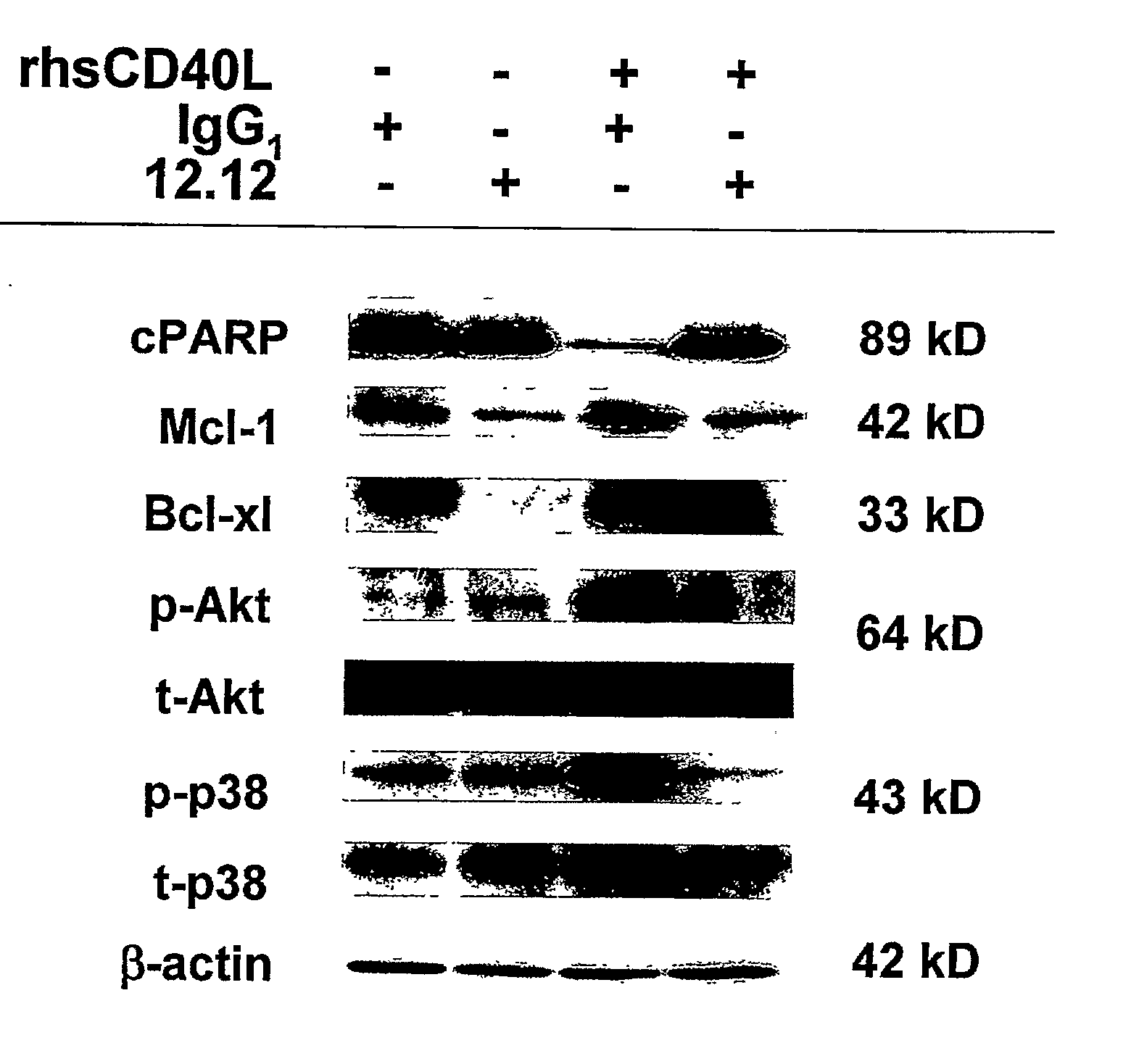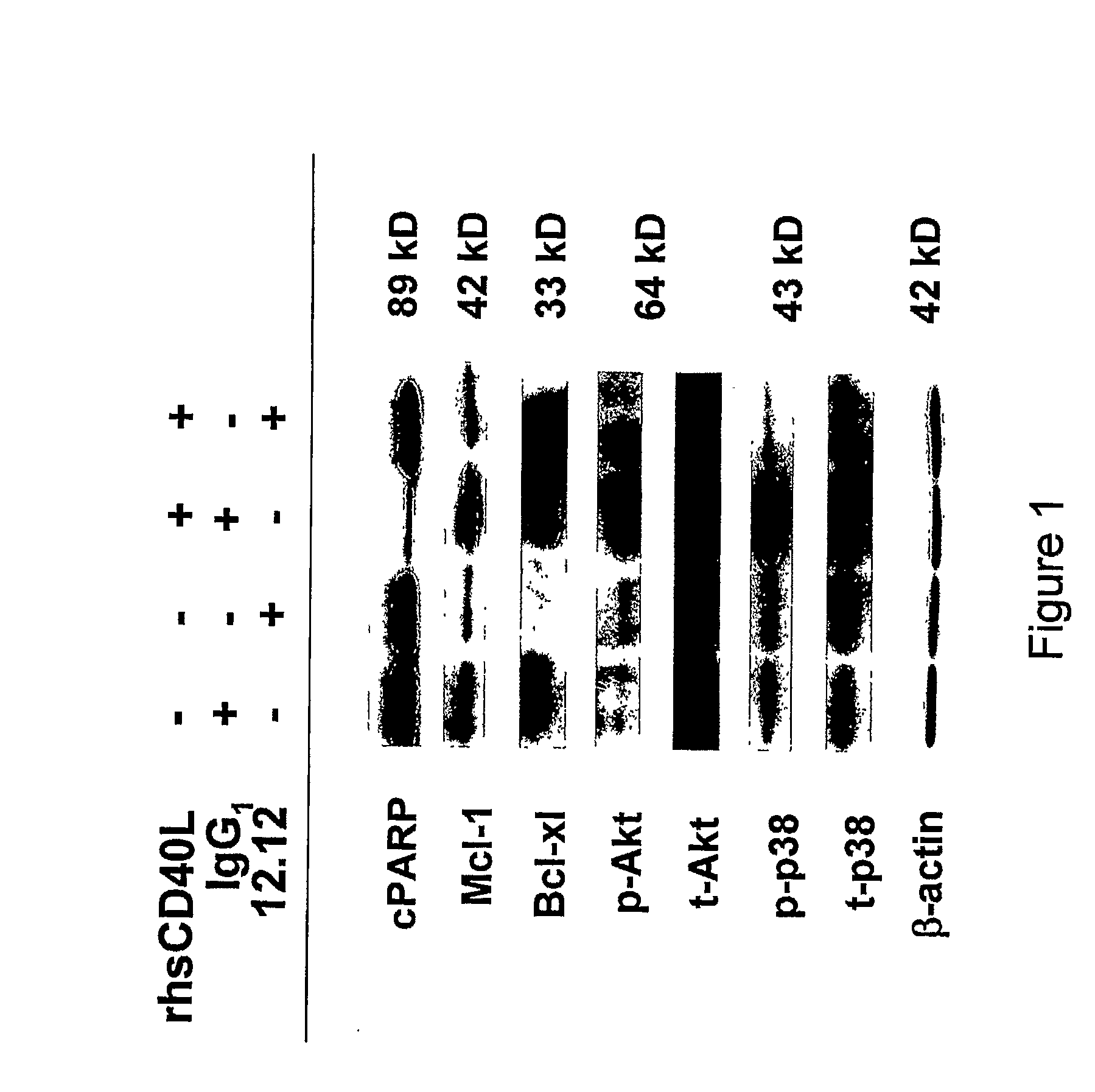[0013]Methods for identifying subjects having an inflammatory disease and / or autoimmune disease that will benefit from anti-CD40 therapeutic agents including those that modulate CD40L-mediated signaling and / or modulate antibody-dependent cellular cytotoxicity (ADCC) are provided. Such anti-CD40 therapeutic agents include, but are not limited to, antagonist anti-CD40 antibodies, antagonist anti-CD40L antibodies, and pharmacologic agents that block or interfere with CD40 / CD40L interaction, particularly CD40L-mediated CD40 signaling, as well as antagonist anti-CD40 antibodies that additionally, or alternatively, have ADCC activity as a mode of action. In some embodiments, the methods comprise the use of biomarkers of cellular apoptosis, cell proliferation and survival, and CD40 signaling pathways to monitor ex vivo cellular response to one or more anti-CD40 therapeutic agents of interest. These ex vivo prognostic assays comprise providing a test biological sample and a control biological sample from a candidate subject, where these biological samples comprise CD40-expressing cells that have been stimulated with a CD40 ligand, either in vivo or ex vivo; contacting the test biological sample with the anti-CD40 therapeutic agent of interest; detecting the expression level of at least one biomarker within the test biological sample; and comparing the expression level of the biomarker(s) with the corresponding expression level detected in the control biological sample that has not been contacted with the anti-CD40 therapeutic agent of interest. Biomarkers for use in these ex vivo prognostic assays include proteins and / or genes whose expression levels are prognostic indicators of responsiveness to treatment intervention, including biomarkers of cellular apoptosis, biomarkers of CD40L-mediated CD40 signaling pathways, and biomarkers of cell proliferation or survival, depending upon the mode of action of the anti-CD40 therapeutic agent. Where the anti-CD40 therapeutic agent has its mode of action via disruption of CD40L-mediated CD40 signaling, biomarkers of cellular apoptosis, CD40L-mediated CD40 signaling pathways, and cell proliferation or survival can be used in these ex vivo prognostic assays. In some embodiments, additional markers of CD40L-mediated CD40 signaling can be assayed, including, but not limited to, cytokines that are upregulated via CD40L-CD40 interaction, for example, vascular endothelial growth factor (VEGF), interleukin (IL)-6, IL-8, IL-10, tumor necrosis factor-α (TNF-α), monocyte chemoattractant protein-1 (MCP-1), and macrophage inflammatory protein-1β (MIP-1β). Where the anti-CD40 therapeutic agent has its mode of action via ADCC, for example, an anti-CD40 antibody, biomarkers of cellular apoptosis can be used in these ex vivo prognostic assays.
[0014]In other embodiments of the invention, candidate subjects are screened for the expression level of one or more CD40-related factors that are predictive of an individual, or a subpopulation of individuals, who will benefit from intervention with anti-CD40 therapeutic agents. Thus, in one embodiment, biological samples collected from candidate subjects, for example, subjects having a disease comprising an autoimmune and / or inflammatory component, are screened for one or more CD40-related factors selected from the group consisting of expression level of cell-surface CD40 antigen on cells of a biological sample, expression level of cell-surface CD40L on cells of a biological sample, circulating level of soluble CD40 (sCD40), and circulating level of soluble CD40L (sCD40L). These CD40-related factors can be prognostic indicators of the disease, and can further be used to identify subjects who would or would not respond to therapeutic intervention with anti-CD40 therapeutic agents, regardless of the mode of action of the anti-CD40 therapeutic agent. An elevated level of expression of one or more of these CD40-related factors within a biological sample when compared to a control or reference standard would be indicative of an individual who would benefit from therapeutic intervention with an anti-CD40 therapeutic agent that modulates CD40L-mediated CD40 signaling, modulates ADCC, or both. Candidate subjects identified with this screening process can be treated with an anti-CD40 therapeutic agent of interest, or can be further screened for responsiveness to anti-CD40 therapeutic agents using the ex vivo prognostic assays described herein.
[0015]In yet other embodiments, candidate subjects are screened for the presence or absence of one or more clinically useful prognostic markers in order to define subpopulations of candidate subjects who have a poor prognosis with other classes of therapeutics but who will benefit from intervention with anti-CD40 therapeutic agents. In this manner, biological samples collected from candidate subjects are screened for one or more clinically useful prognostic markers known to be indicators of poor prognosis with current therapeutics whose mode of action is not via CD40 targeting or CD40L-mediated CD40 signaling. Any clinically useful prognostic marker for a given autoimmune or inflammatory disease can be included in the screening process. Candidate subjects within a subpopulation identified with this screening process can be further screened for responsiveness to anti-CD40 therapeutic agents using the ex vivo prognostic assays described herein.
[0016]The present invention also provides methods for monitoring efficacy of an anti-CD40 therapeutic agent in treatment of a subject having an inflammatory disease or autoimmune disease. In this manner, a subject undergoing therapy with an anti-CD40 therapeutic agent, who may or may not have been previously screened using an ex vivo prognostic assay disclosed herein, is monitored for in vivo changes in the expression of at least one biomarker of cellular apoptosis, cell proliferation and survival, and / or one or more CD40L-mediated CD40 signaling pathways following treatment with the anti-CD40 therapeutic agent. The particular biomarkers to be assayed can be chosen based on mode of action of the therapeutic agent as noted above. Alternatively, or additionally, the subject can be monitored for in vivo changes in the expression level of one or more CD40-related factors selected from the group consisting of cell-surface CD40 antigen on cells, cell-surface CD40L on cells, circulating level of sCD40, and circulating level of sCD40L following treatment with the anti-CD40 therapeutic agent. In this manner, a first biological sample is obtained from the subject and assayed for the expression level of one or more of these biomarkers and / or CD40-related factors to obtain a baseline level of expression for each factor assayed, and then one or more subsequent biological samples is obtained from the subject and assayed for the same biomarker(s) and / or CD40-related factor(s), where the subsequent biological sample is obtained following the administration of at least one dose of the anti-CD40 therapeutic agent of interest. Monitoring can occur at a single point in time, or at multiple points in time, to ascertain efficacy of any given treatment protocol wherein the anti-CD40 therapeutic agent is administered to the subject. Depending upon the biomarker being assayed, a decrease or increase in the expression level of the biomarker between any two time points can be indicative of efficacy of the anti-CD40 therapeutic agent in treatment of the inflammatory disease or autoimmune disease. Where monitoring reveals a decrease in the expression level of one or more of the CD40-related factors, such a result can be indicative of efficacy of the anti-CD40 therapeutic agent in treatment of the inflammatory disease or autoimmune disease.
[0017]Expression level of these various biomarkers and CD40-related factors, and any clinically useful prognostic markers in a biological sample can be detected at the protein or nucleic acid level, using, for example, immunohistochemistry techniques or nucleic acid-based techniques such as in situ hybridization and RT-PCR. In some embodiments, an elevated level or an increase in expression of at least one biomarker is indicative of a positive therapeutic response to treatment with an anti-CD40 therapeutic agent. In other embodiments, a diminished level or a decrease in expression of at least one biomarker is indicative of a positive therapeutic response to treatment with the anti-CD40 therapeutic agent.
[0018]The methods of the present invention can be used to identify subjects for whom anti-CD40 therapeutic intervention would be beneficial in preventing, ameliorating, or treating diseases comprising an autoimmune and / or inflammatory component, including, but not limited to, autoimmune and inflammatory diseases such as systemic lupus erythematosus (SLE), discoid lupus, lupus nephritis, sarcoidosis, inflammatory arthritis, including, but not limited to, juvenile arthritis, rheumatoid arthritis, psoriatic arthritis, Reiter's syndrome, ankylosing spondylitis, and gouty arthritis, rejection of an organ or tissue transplant, hyperacute, acute, or chronic rejection and / or graft versus host disease, multiple sclerosis, hyper IgE syndrome, polyarteritis nodosa, primary biliary cirrhosis, inflammatory bowel disease, Crohn's disease, celiac's disease (gluten-sensitive enteropathy), autoimmune hepatitis, pernicious anemia, autoimmune hemolytic anemia, psoriasis, scleroderma, myasthenia gravis, autoimmune thrombocytopenic purpura, autoimmune thyroiditis, Grave's disease, Hasimoto's thyroiditis, immune complex disease, chronic fatigue immune dysfunction syndrome (CFIDS), polymyositis and dermatomyositis, cryoglobulinemia, thrombolysis, cardiomyopathy, pemphigus vulgaris, pulmonary interstitial fibrosis, sarcoidosis, Type I and Type II diabetes mellitus, type 1, 2, 3, and 4 delayed-type hypersensitivity, allergy or allergic disorders, unwanted / unintended immune responses to therapeutic proteins, asthma, Churg-Strauss syndrome (allergic granulomatosis), atopic dermatitis, allergic and irritant contact dermatitis, urtecaria, IgE-mediated allergy, atherosclerosis, vasculitis, idiopathic inflammatory myopathies, hemolytic disease, Alzheimer's disease, chronic inflammatory demyelinating polyneuropathy, and the like.
 Login to View More
Login to View More 


